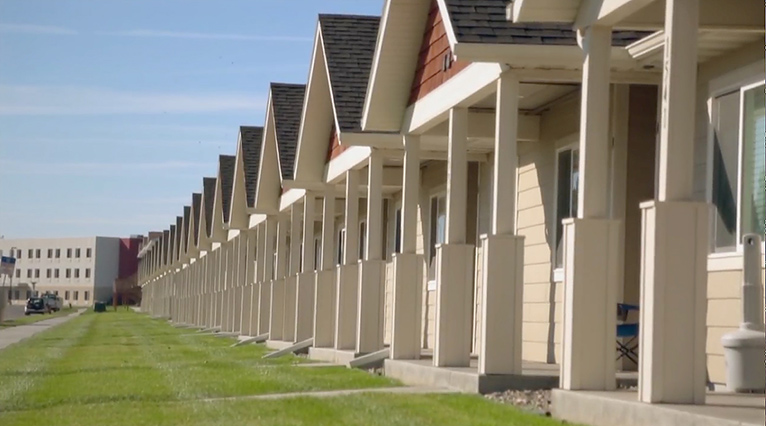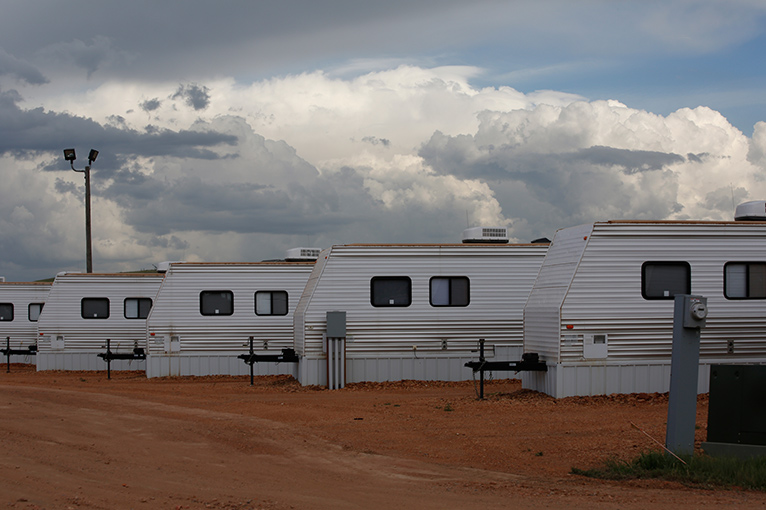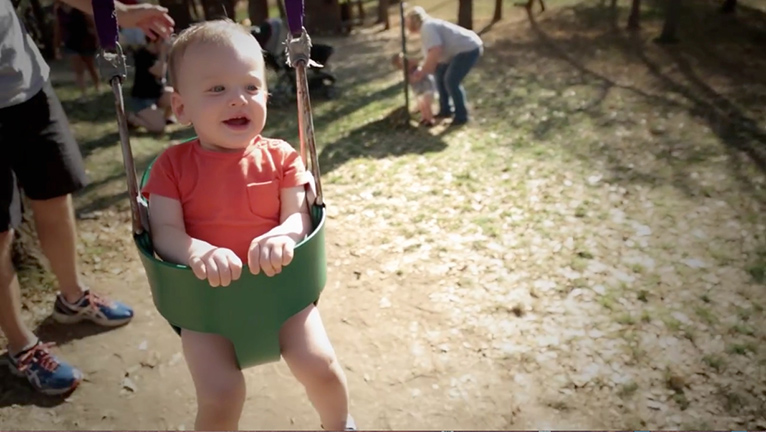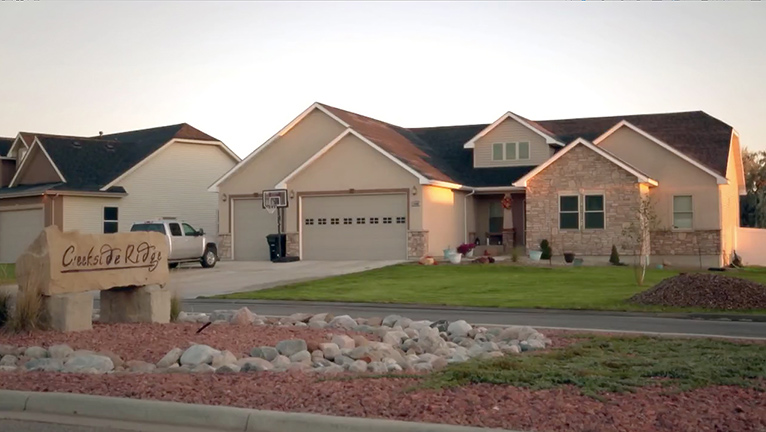If human-made climate change is irrefutable, why are we still fracking? What teaches us to believe there is no alternative to oil?
WILLISTON, North Dakota, the epicenter of the Bakken shale oil boom, has launched a new campaign branding itself “the last great place for opportunity.” This slogan comes at the end of a promotional video that features hard-working entrepreneurs testifying to the limitless opportunities that await you in western North Dakota. The radiating exclamation point punctuates the slogan by exploding over a spare grid, connoting a clean slate ready to be filled with a brighter future. If history leaves its traces in punctuation marks, as Theodore Adorno argues, then the overzealousness of this exclamation point, casting a warm glow over our future prospects, might also signal a menacing threat rather than an auspicious omen. Similarly, the “last” in “last great place for opportunity” seems to indicate that we have entered into an end times of sorts, having crossed over a threshold from which there is no return. But never mind these paranoid readings; for now let’s focus on the video’s upbeat message about possibility in this place of wholesome renewal.
Deploying what has become a standard set of conventions for promotional videos and advertisements—DSLR cinematography with shallow focus, upbeat pop music, flat gestures toward multiculturalism, etc.—the video attempts to counter the boomtown narrative perpetuated about Williston in the national media. In that narrative, Williston is dangerous, full of male oil workers and prostitutes, and enjoying an impermanent prosperity, subject to the same boom and bust cycles that have plagued the region since the first oil-exploration projects in the 1950s. The video counters the boomtown story by positioning Williston as a place of certain and stable economic growth.
What does it feel like to live in the last great place for opportunity? “It’s almost like, whenever you think of the American Dream, that’s what it’s like to be in Williston,” a young woman tells us as the video commences while b-roll of an American flag flaps in the wind. In a world full of missed opportunities, dead ends, and foreclosed dreams, Williston is a place where hard work still translates into stability and security. It is simultaneously a place where the entrepreneurial spirit is allowed to flourish. “Anybody who has any potential who wants to work can make it here” we are told by an elderly woman; “everybody’s here because they want to succeed, they want to change their life…they want to start over” a middle-age man reiterates; “this town has given anybody who wants to try to open up their own business a great opportunity,” an owner of a Culver’s restaurant explains as he laughs with his employee. The words growth, opportunity, exciting, and succeed pop from the mouths of Williston residents as they describe what makes their home great. Williston is a place where everyone is invited to participate in abundance, and this abundance is shared among the town’s residents in an equitable manner. Opportunity is there for the taking, that is, for those enterprising go-getters willing to sweat in the pursuit of a better life.

Central to the video’s vision of the thriving American dream is the growth of the town and the development of housing stock to suit its utopian vision: suburban-style tract homes. In the wake of the subprime market crash and the decimation of the American middle class, these homes offer a nostalgic comfort, a promise to extend the suburban project, imagining Williston as a microcosm for the repetition of the post–World War II boom. The video celebrates the measured symmetry of the landscape currently under construction as an index of the normalized family units that live within them. After sweeping footage of newly minted suburban sprawl, we are told by a housing developer that Williston residents “want to be a family structure, and that’s what the real dream is all about.” The fixation on the development of tracts of single-family homes by Williston’s city planners is fed by the notion that they must establish permanence in a transient city by settling the population and promoting social reproduction. The single-family home becomes a biopolitical measure that serves as the counterpoint to the instability and perceived danger of the man camp. “Williston, the last great place for opportunity!” thus replaces the Williston Economic Department’s previous slogan that celebrated the virility of frack drilling: “Rockin’ the Bakken.”
One of the most striking things about the Williston video is (despite its attempts to present a diverse face) the sheer abundance of white children that populate its new vision of opportunity. “Thousands of babies are being born each year in the community,” a member of the Williston Economic Development team tells us as a toddler is pushed on a swing. Of these thousands of babies, the only ones we see are white. The promise of renewal in the last great place for opportunity is thus coded not only as the renewal of the middle class but the renewal of white America itself. This is not surprising, given that in the U.S. the promise of freedom and self-determination through homeownership has historically been predicated on racial exclusion and the violent marking of suburban spaces of social reproduction as white. It’s an essential point to draw out, though, because it parallels the tradition of homesteading by white settlers so central to the establishment North Dakota as a frontier space that erased histories of racial injustice, genocide, and the continued brutalization and expropriation of Native land and communities. This history has only been extended by the current boom, the most extreme example being the spike in violence against Native women since it began.
The version of social reproduction inherent to suburban development cannot be separated from the rise of petrocapitalism in the 20th century, according to geographer Matthew Huber. Moreover, in Lifeblood, his recent book on the quotidian politics of oil, he argues that the entrepreneurial subjectivities we associate with neoliberalism are impossible
without the material transformation of everyday life centered upon reproductive geographies of single-family home ownership, automobility, and voracious energy consumption. The dense, versatile fuel of petroleum fuels a particular lived geography—a “structure of feeling”—that allows for an appearance of atomized command over the spaces of mobility, home, and even the body itself.
Huber locates the emergence of neoliberal policies and practices in the suburbanization of the American landscape of the postwar era, claiming that the mobility fueled by petrocapitalism was also central to the capacity of the American subject to understand her life as capital. Moreover, the necessity of purchasing the implements of this “fractioned” subjectivity—namely the car and the single-family home—“also immediately extends the mass of living labor into circuits of credit, debt, and financial markets.” In other words, neither the emergence of entrepreneurial subjectivities nor the related financialization of daily life can be separated from the suburbanization of American life enabled by the abundance of cheap oil.

Just as the politics of racial exclusion are rendered invisible in Williston’s branding campaign, so are the ways that oil itself functions as the unspoken yet ever-present force behind the burgeoning entrepreneurial subjectivities in the video. Participating in these double erasures, the video does more than simply counter the boomtown narrative by repeating tropes of lily-white suburban life. Instead, in the process of branding Williston as the “last great place for opportunity,” the video both participates in and furthers a genre I would like to call anthropocene realism. Drawing on Mark Fisher’s diagnosis of the neoliberal era as the establishment of a dominant genre he calls “capitalist realism,” or the active production of the sense that, in Margret Thatcher’s words, “there is no alternative” to the neoliberal agenda, I suggest that anthropocene realism is a genre that substantiates a similar sense that there is no alternative to the so-called energy revolution currently taking place in the U.S.
In The Boom, Russell Gold, senior energy reporter for the Wall Street Journal, gives an account of the implementation of fracking technologies since 2010, arguing that it has transformed the discursive practices and material politics around oil in the U.S. and globally. In a few short years, the anxiety around peak oil has been erased, and the geopolitics of American oil consumption has been transformed into nominal “energy independence.” As fracking technologies open untapped fossil fuel reserves to extraction, U.S. oil production is expected to reach 11.1 million barrels a day by 2020, surpassing production rates in Saudi Arabia, currently the world’s highest. At its peak in June 2015 the output of oil from the Bakken alone reached 1.2 million barrels a day.
The emergence of anthropocene realism is based on the coincidence of this advancement of fracking technologies with two major historical events. The first is the widespread acceptance of human-driven climate change as irrefutable scientific fact, especially with the publication of the 2007 report from the United Nations Intergovernmental Panel on Climate Change that established incontrovertible evidence of anthropogenic causality in the literature. The Bakken oil boom began in 2008 at a time when climate-change denial, the primary tool by which both politicians and the oil industry refuted the legitimacy of claims linking the burning of fossil fuels to global warming, was increasingly untenable. At a moment when climate scientists insist that the only viable way to prevent catastrophic climate change is to leave the world’s oil reserves in the ground, the acceleration of oil extraction requires the same “structure of disavowal” that Fisher finds central to capitalist realism. Following Žižek’s understanding of disavowal as central to ideology in postmodernity, Fisher writes, “So long as we believe (in our hearts) that capitalism is bad, we are free to continue to participate in capitalist exchange.” In the structure of disavowal, belief and action are separated. Yes, yes, we know climate change is a real, terrible thing, but we act as if the extraction of oil is necessary, the only viable solution to secure a sustainable future. As a society, we may have come to accept that climate change is a real and terrifying prospect, but we don’t complain when, for instance, our 401(k)s rebound, thanks in part to the fracking-inspired gold rush in the American fossil-fuel industry.

This leads me to the second major historical event with which the Williston fracking boom coincided, which is, of course, the 2008 financial crisis, or what Duménil and Lévy call “the crisis of neoliberalism” and the widespread collapse in the belief that the unbridled expansion of financial capitalism, deregulation, and union-busting would lead to long-term prosperity. In addition to supplying a stream of indebted laborers to the Bakken who lost their homes and jobs, the financial crisis also allowed the prosperity of the new fracking revolution to stand in stark contrast with the devastation of the rest of the country. This juxtaposition positioned the “energy revolution” as the beacon of hope for a beleaguered population, an alternative—perhaps the only alternative—to precarity and economic devastation. This is the perfect storm that let Williston emerge as the last great place for opportunity. “We’ve moved from a boomtown to a business model. Everyone is coming here to call Williston their home.” These words, from a Williston Economic Development representative, tell the story of an inevitable transition from instability to perpetuity. It is a perfect piece of anthropocene realism: a home for “everyone” built by a vague “business model” predicated on the endless but invisible flow of oil (a model that has, in the case of Williston, become increasingly flimsy since the recent drop in global oil prices).
In Cruel Optimism, Lauren Berlant describes genre as that which organizes attachments and expectations as experience unfolds. Genre, for Berlant, is a set of pre-established forms that provides a structure to narrate both the present and the future, and she shows that the attachments organized by specific genres can be, and often are, perverse and destructive. Naming anthropocene realism, or the sense that there is no end and no alternative to petrocapitalism, requires more than recognizing our “addiction” to oil, a point that Matt Huber makes very clear. Instead, it requires identifying the ways that our attachments to certain versions of the good life are tied to geographies of racial exclusion and bound up in petrocapitalism.
If the mood of capitalist realism is depression, as Mark Fisher argues, than the mood of anthropocene realism might be read as anxious exuberance. This exuberance presents itself in comforting tropes that, in their “impotent bigness” (to use the words of Jacqueline Rose), feel both worn thin and lacking in confidence. On closer look, the exclamation point looks desperate, as do all the forced smiles and awkward testimonials in the Williston promotional video. It is tempting to dismiss its pathos as the futile efforts of a culture in decline, but that would be too easy. We know there are other, less suicidal visions for the future than those offered by anthropocene realism. But to access them we must first assess the ways our sense of opportunity and our vision for our individual futures are tethered to petrocapitalism, whether we like it or not.
